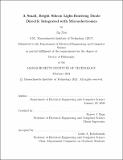| dc.contributor.advisor | Rajeev J. Ram. | en_US |
| dc.contributor.author | Xue, Jin,Ph. D.Massachusetts Institute of Technology. | en_US |
| dc.contributor.other | Massachusetts Institute of Technology. Department of Electrical Engineering and Computer Science. | en_US |
| dc.date.accessioned | 2021-05-24T20:23:39Z | |
| dc.date.available | 2021-05-24T20:23:39Z | |
| dc.date.copyright | 2021 | en_US |
| dc.date.issued | 2021 | en_US |
| dc.identifier.uri | https://hdl.handle.net/1721.1/130779 | |
| dc.description | Thesis: Ph. D., Massachusetts Institute of Technology, Department of Electrical Engineering and Computer Science, February, 2021 | en_US |
| dc.description | Cataloged from the official PDF of thesis. | en_US |
| dc.description | Includes bibliographical references (pages 191-213). | en_US |
| dc.description.abstract | Silicon technologies have been developed for both electronics and photonics. Future demands call for further innovation in each field separately, but also depend on our ability to bring the best of both worlds together through integrated solutions. For decades, the pursuit of all-silicon electronic-photonic integration has been hindered by the lack of a native light source due to silicon's indirect bandgap. Considerable effort has been expended for light generation from silicon by altering material structure or composition, but a useful device with practical output intensity has yet to be achieved. In this thesis, I demonstrate near-infrared, micro- and nanoscale light emitting diodes (LEDs) in native silicon that realize high radiation intensity and useful output power, achieved in an unmodified open-foundry microelectronic 55nm CMOS process, along with other photonic and electronic components integrated on the same chip. Efficient bipolar carrier injection and tight confinement for radiative recombination in sub-wavelength dimensions allow us to achieve intense electroluminescence with designs leveraging high-quality passivation of material interfaces. Under room-temperature continuous-wave operation, an external light emission intensity of over 500W/cm² from a single nano-LED is demonstrated, which is several orders of magnitude higher than previous silicon-based emitters, and surpasses the state-of-the-art nano- or microscale LEDs using direct-bandgap III-V semiconductors. An all-silicon, chip-to-chip fiber optic communication link is demonstrated as well as light sources with sufficient power for use as illumination sources for macroscopic objects. | en_US |
| dc.description.statementofresponsibility | by Jin Xue. | en_US |
| dc.format.extent | 213 pages | en_US |
| dc.language.iso | eng | en_US |
| dc.publisher | Massachusetts Institute of Technology | en_US |
| dc.rights | MIT theses may be protected by copyright. Please reuse MIT thesis content according to the MIT Libraries Permissions Policy, which is available through the URL provided. | en_US |
| dc.rights.uri | http://dspace.mit.edu/handle/1721.1/7582 | en_US |
| dc.subject | Electrical Engineering and Computer Science. | en_US |
| dc.title | A small, bright silicon light-emitting diode directly integrated with microelectronics | en_US |
| dc.type | Thesis | en_US |
| dc.description.degree | Ph. D. | en_US |
| dc.contributor.department | Massachusetts Institute of Technology. Department of Electrical Engineering and Computer Science | en_US |
| dc.identifier.oclc | 1252062590 | en_US |
| dc.description.collection | Ph.D. Massachusetts Institute of Technology, Department of Electrical Engineering and Computer Science | en_US |
| dspace.imported | 2021-05-24T20:23:39Z | en_US |
| mit.thesis.degree | Doctoral | en_US |
| mit.thesis.department | EECS | en_US |
